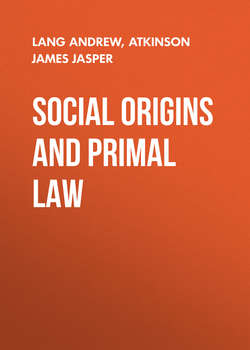Читать книгу Social Origins and Primal Law - Lang Andrew - Страница 18
CHAPTER II
THE CLASS SYSTEM
THE 'PRIMARY DIVISIONS' ARE THEMSELVES TOTEMIC AND EXOGAMOUS
ОглавлениеWe see that, of the two 'phratries' Yungaru and Wutaru, Yungaru is 'opossum' (according to Mr. Chatfield) or 'alligator' (according to Mr. Bridgman); while Wutaru is 'kangaroo.' These two primary 'phratries,' therefore, have totemic names, and (in my opinion) were originally two local totem groups, each containing members of various totems derived from alien mothers. The same thing may be true when the meanings of the 'primary class names' ('phratries') can no longer be discovered. If so, the 'primary divisions' are, in origin, mere totem distinctions, involving, I think, the pre-existence of the rule of exogamy, which is also involved in the rules of the 'primary divisions.' Mr. Fison writes (what is obvious) 'in some places the primary divisions are distinguished by totem names at the present day.'70
'Probably they were so distinguished everywhere, in ancient times,' he adds, and this is certainly the case in North America, as we shall see later. Mr. Fison's opinion is my own so far, and, if it is right, if the 'primary class divisions' ('phratries'), within which marriage is now forbidden, were originally two totem divisions, then Totemism is earlier than the 'primary divisions.' On this point Messrs. Fison and Howitt say that the divisions on which marriage regulations are based 'are denoted by class names or by totems – frequently by both class names and totems.' In a note they add, 'Class names, so called by us solely for the sake of convenience, and because they cannot always be positively asserted to be totems, though the strong probability is that they are always totems.'71
By 'class names' the authors, I think, here mean the names of the 'primary exogamous divisions' or 'phratries.' These are often, if not always, known by totem names. But the 'classes,' as distinguished from the 'phratries,' are not known by totemic names, as far as I am aware. Herr Cunow, we shall see, asserts that in some cases they denote mere seniority, 'big' and 'little,' 'young' and 'old.' Unless they can be proved to be totemic, we must, I repeat, carefully avoid confusing the 'classes,' four or eight, with the 'phratries,' in which they are included. The confusion is general and very misleading.
Totemism, according to Mr. McLennan, preceded exogamy, and made exogamy possible. Thus totem distinctions, with exogamy, may be older than the 'two primary class exogamous divisions,' in which, according to most authorities, exogamy began. Mr. Tylor is cautious: 'the dual form of exogamy' (the 'phratries,' or 'two primary divisions') 'may be the original form,' or at least that view is tenable.72 The origin of exogamy is, however, unknown, in Mr. Tylor's opinion, which commits him to nothing.
Mr. Howitt, if I do not misinterpret him, also regards the two divisions, 'phratries,' as primary, but at the same time agrees with me, and Mr. Fison, that the two 'phratry' divisions were themselves in origin totemic.
70
Kamilaroi and Kurnai, p. 40.
71
J. A. I. xiv. 142.
72
Journal of the Anthropological Institute, xviii. 264.
